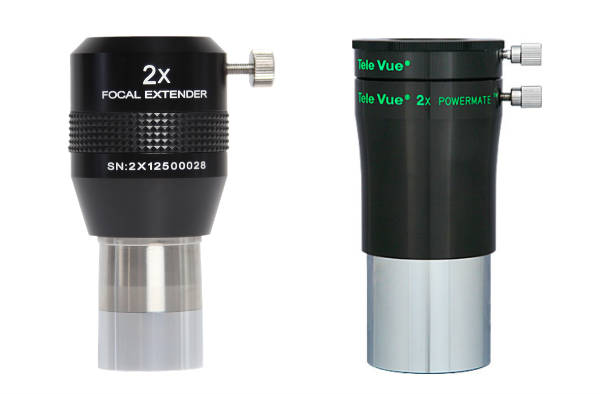
Explore Scientific Focal Extenders and TeleVue Powermates are examples of Telecentric lenses. Photos are not to scale.
Most of us have been there. You want more magnification then your lowest focal length eyepiece can give so you turn to a multiplier. But wait – Barlows, Powermates, Focal Extenders? Are these interchangeable in use? If not, how do they behave differently at the eyepiece?
Both Barlows and Telecentrics magnify by reducing the effective focal length of the eyepiece. Since exit pupil is a function of magnification (remember that exit pupil in mm = telescope aperture in mm / magnification), for a given telescope it will be equally affected by a Barlow and Telecentric working at the same power.
A Barlow is a two element negative lens that adds magnification by expanding the image scale. A Telecentric is based on the Barlow design and adds a two element positive lens following the negative lens set. The differences in designs do result some differences in use.
Eye Relief
A Barlow will increase the eye relief of the eyepiece it is used with while a Telecentric will not. For short focal length eyepieces with limited eye relief the Barlow’s effect on eye relief can be quite welcome. But when a Barlow is used with longer focal length eyepieces it can become harder to find the right spot to position your eye without blackouts.
For this reason I don’t like to use a Barlow with eyepieces longer than 12mm. But since the times when I want to use any kind of multiplier with a longer eyepiece are rare this isn’t much of a limitation in practice.
Magnification
A Barlow’s magnification is dependent on the distance from the eyepiece while a Telecentric’s multiplier will remain largely constant. Standard use is to insert the eyepiece into the Barlow to get the specified multiplication. If you move the eyepiece further from the Barlow, say by using an extension tube or putting the Barlow in front of a diagonal, the magnification will increase. Likewise if you decrease the distance between the Barlow and the eyepiece the magnification will decrease.
Some Barlows take advantage of this characteristic by allowing the lens to be removed from the body and threaded directly onto the filter threads for the eyepiece giving a second magnification factor. For example, the Baader Q-Barlow has a standard multiplier of 2.25x and gives 1.3x when the lens is threaded directly to the eyepiece.
It is also conceivable that you may want to position the multiplier somewhere else in the chain without changing magnification. Imaging applications come to mind most readily but there are probably others as well and in these cases a Telecentric would be the type to use.
Focal Plane
The effect on the light path from the Barlow’s negative focal length lens results in the need to rack the focuser in 10-20mm. The additional positive lens of a Telecentric negates the effect though it may still require a small amount of focus adjustment depending on the eyepiece used.
A Barlow can be useful when attempting to use a Binoviewer or camera on a telescope that does not have enough back focus to allow the image to focus at infinity with the focuser racked all the way in.
Optical Quality
Good quality examples of each type of modifier lens are readily found. Personally I’ve gotten excellent results from the previously mentioned Baader Q-Barlow and Explore Scientific Focal Extenders. In terms of “transparency” I haven’t noticed any difference between the two classes in my observing.
When deciding which type of multiplier to use the choice comes down to the differences we’ve already covered or physical characteristics such as size and weight. I’m glad to have both Barlows and Telecentrics in my eyepiece collection.
-Dave
Original content copyright 2015 by David Philips. All Rights Reserved. This post may contain links to affiliate sites; sales through affiliate links may benefit this site.